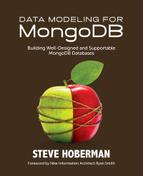|
|
$inc, 69, 73
$set, 72, 73, 194
1NF. See first normal form
2NF. See second normal form
3NF. See third normal form
abstraction, 132–34, 138, 180, 199
ACID. See Atomic, Consistent, Isolated, and Durable
alternate key. See key, alternate
Amazon, 14, 22, 70, 193
ambassador, 16, 17
architect, 199
associative entity, 200
Atomic, Consistent, Isolated, and Durable, 20, 199
attribute, 37, 200
conceptual level, 37
logical level, 37
physical level, 37
Axis Technique, 9, 108
Barnes & Noble, 14
BASE. See Basically Available, Soft-state, Eventual consistency
Basically Available, Soft-state, Eventual consistency, 21, 200
business analyst, 9, 200
business assertions, 8, 15, 104, 134
business professional, 9, 200
business sketch, 105
C++, 27
candidate key. See key, candidate
characteristics of, 47
selection process for choosing, 50
cardinality, 41, 200
CDM. See conceptual data model
chaos, 124
class diagram, 15
classword, 115, 201
collection, 36–37, 201
Collection History Template, 150, 151, 152, 185
column, 37
column-oriented, 24, 29, 201
composite key, 47
concept, 84, 110, 201
concept definition, 16
Concept Template, 91, 93, 164
conceptual data model, 79, 83, 110, 201
reasons for, 84
steps to complete, 85, 162
conformed dimension, 201
creativity, 15
data architect, 9
data element. See attribute
data model, 8–9, 17, 202
map analogy for, 7
precision in a, 11
data modeler, 9, 45, 202
creativity of, 9, 15
data modeling, 1, 15, 202
80/20 rule of, 16
iterative process of, 12
questions asked during, 12
uses for, 9–11, 17
database administrator, 9, 202
database developer, 9
DBA. See database administrator
degenerate dimension, 150
denormalization, 202
dependent entity. See entity, dependent
developer, 9, 202
dimension, 107
dimensional data model, 78, 138, 203
document, 35–36
document-oriented, 24, 25, 29, 203
domain, 39, 203
type of, 39
driver, 27
embed, 141
embed vs. reference, 141–45, 182
entity, 32, 203
categories for, 32, 92
conceptual level, 33
dependent, 142
independent, 142
logical level, 33
physical level, 34
entity instance, 32, 204
extensibility, 25
field, 37–39, 204
field name, 38, 39, 68
field value, 38
find( ), 67–70
first normal form, 123, 125–27, 173
foreign key. See key, foreign
forward engineer, 10, 204
Fully Communication Oriented Information Modeling, 9
Globally Unique Identifier, 31, 53, 62
grain, 204
graph, 24, 29, 204
GUID. See Globally Unique Identifier
hierarchy, 43
horizontal partitioning. See partitioning, horizontal
How, 32, 92
IDEF1X. See Integration Definition for Information Modeling
identity, 59
IE. See Information Engineering
independent entity. See entity, independent
index, 153, 204
Information Engineering, 9, 15
initial chaos, 124–25
insert( ), 63–66
integration, 52
Integration Definition for Information Modeling, 15
inversion entry. See key, inversion entry
key, 47
alternate, 50, 199
candidate, 47, 200
foreign, 54, 204
inversion entry, 55
natural, 52, 205
primary, 50, 122, 206
secondary, 55
surrogate, 51, 208
key-value, 24, 29, 205
LDM. See logical data model
logical data model, 79, 111, 205
mapping using, 112
steps to complete, 113, 169
measure, 205
metadata, 205
meter, 107, 137, 205
modeling pyramid, 77
MongoDB
datatypes in, 40
four properties of, 25–27
installation of, 27–28
RDBMS and data model object comparison with, 31
natural key. See key, natural
network, 43
non-unique index, 56
normalization, 122–36, 138, 205
NoSQL, 19, 29, 205
history of, 19
RDBMS versus, 19
types of, 22–25
object, 3, 206
Object Role Modeling, 15
ObjectId, 53, 65
operator, 68
organizer, 15
ORM. See Object Role Modeling
parent reference, 45–47
partition, 206
partitioning
horizontal, 153, 155, 186
vertical, 153, 155, 186
PDM. See physical data model
physical data model, 79, 139, 206
steps to complete, 140, 182
precision, 11
primary key. See key, primary
program, 206
project, 206
Properties Template, 113, 114, 117, 120, 169, 170
Property Characteristics Template, 114, 116, 119, 121, 169, 170, 171
Python, 27
Questions Template, 97, 166
RDBMS. See Relational Database Management System
record, 35
recursive relationship. See relationship, recursive
reference, 55, 141
relational data model, 78
Relational Database Management System, 3, 207
relational versus dimensional, 78, 89
relationship, 41, 207
conceptual level, 43
logical level, 43
physical level, 43
reading a, 42
recursive, 43
remove( ), 74–75
reverse engineer, 11, 207
risk mitigation, 10
rolldown, 59
rollup, 60
Ruby, 27
scaling, 20, 26
second normal form, 123, 128
secondary key. See key, secondary
sharding, 20, 111, 139, 140, 153, 155, 159, 186, 206
slowly changing dimension (SCD), 207
SME. See subject matter expert
spreadsheet, 13, 208
stakeholder, 208
star schema, 149, 155, 208
subject matter expert, 208
subtype, 58, 148
subtyping, 56–58
supertype, 58
surrogate key. See key, surrogate
table, 36
technical debt, 80
third normal form, 123, 180
UML. See Unified Modeling Language
Unified Modeling Language, 8, 9, 15, 41
unique index, 51
update( ), 70–73
user, 208
vertical partitioning. See partitioning, vertical
view, 208
What, 32, 92
When, 32, 92
Where, 32, 92
Who, 32, 92
Why, 32, 92

